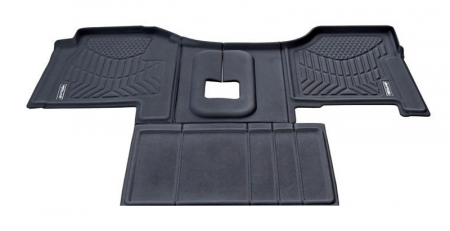More And More Couples Are Trucking Together — And Loving It
Though Art Johnson and Amanda Jones had been seeing each other for a year, they rarely had a chance to actually see each other at all. Art was working as a local truck driver for a meat-packing plant, where he hauled offal through Alberta and Saskatchewan in Canada. Amanda was at the meatpacking plant, too, as a security guard regularly working 12-hour shifts.
“At the end of the long day, I’d get home first, and Art would still be working for four or five hours. We’d end up spending maybe two hours together, then we’d have to go to sleep,” Amanda says.
The opposite schedules were draining, but that wasn’t all. With such low paying jobs, Art and Amanda were living paycheck to paycheck.
“With our combined wages, we couldn’t pay rent and bills, and also eat,” says Amanda.
Then, a genius idea struck. If Art started driving long-distance — and Amanda came with him — the couple would get to spend more time together while slashing their living expenses and earning more than what they were currently taking in combined.
Ten years later, Amanda and Art are still on the road together. And they’re not alone: More women than ever are joining their husbands on the road.
A chance to try something new
 Sometimes it’s a practical career decision for women who have been out of the work force for a while. Primed for a second act, many are going to truckdriving school and teaming with their husbands.
Sometimes it’s a practical career decision for women who have been out of the work force for a while. Primed for a second act, many are going to truckdriving school and teaming with their husbands.
“The average female truck driver is 52-years-old. A lot of them have been home raising kids, but now their kids are grown,” says Ellen Voie, president and CEO of Women in Trucking.
Other times, the decision is rooted in romance and the chance for a new adventure.
Which is exactly how Carolee Moore found herself living in a big rig after she and her husband Bobby got married in 2010. At that point, Bobby had been driving locally in California and Arizona. But as the economy plummeted, doing long-distance hauls for IWX Motor Freight proved the ticket to earning more money. Not wanting to be apart from Carolee, Bobby suggested she join him.
“I was like sure, let’s do that, it sounds like fun,” she says.
But it wasn’t exactly fun at first. While Bobby had grown up in a rough neighborhood and worked in trucking for nearly two decades, Carolee had been used to a slightly different lifestyle in posh Orange County.
“Living in an 8×6 space, only getting showers every few days, that in itself is a major adjustment,” says Bobby, who tried his best to prepare Carolee for life on the road. Still, that first day came as a shock. Carolee had never even sat in a truck, and the one Bobby was driving was dirty, rickety and smelled like smoke. “It was so old and loud, we could barely have a conversation,” she says.
It took a few months for Carolee to get used to the smaller space, as well as to new routines like brushing her teeth in a bowl with bottled water instead of at the sink. She missed her adult kids who still lived in Southern California, too. Even so, she knew joining Bobby had been the right decision. And so did he.
“With her next to me on the road, it felt completely natural. The chemistry is just right,” Bobby says.
With Amanda by his side, driving got better for Art Johansson, too. “It was better after she started coming along just because we got to spend time together,” he says. But he soon realized that was just one of many benefits.
Everyone doing their part
 Like almost everything else these days, driving a truck is more complicated than it used to be. Once Art and Amanda started doing long hauls across the Canada-U.S. border, beefed up security meant that they were slammed with paperwork and the need to keep increasingly detailed logbooks. With Amanda on board, Art now had a partner to help take care of the paperwork. She also helped with navigation, dealing with dispatch and taking care of repairs.
Like almost everything else these days, driving a truck is more complicated than it used to be. Once Art and Amanda started doing long hauls across the Canada-U.S. border, beefed up security meant that they were slammed with paperwork and the need to keep increasingly detailed logbooks. With Amanda on board, Art now had a partner to help take care of the paperwork. She also helped with navigation, dealing with dispatch and taking care of repairs.
To accomplish all this, Amanda is constantly using her smartphone. Using apps like Transflo, Weatherbug, or Drivewyze, she’s able to do everything from handle paperwork electronically to check weather to get better bypass rates.
“I’ve actually had guys say that I’m just like their wife, texting all the time — that’s slightly offensive, considering I’m working, not texting!” she says.
Still, Art was the one earning all the money, and Amanda began to think that it might be a smart idea for her to get her CDL too.
“The thought that something could happen to him and I would be left unemployed without any specialty training or skill scared the crap out of me,” she says. “I thought it was prudent to get licensed. I already knew a lot of the things I needed to know, and just needed to learn the actual driving and steering.”
The additional income and security that Amanda gained as a driver are major benefits, but they’re not the only ones. As one of the few team drivers for their company, JBM Logistics, she and Art are able to deliver loads faster than solo drivers. And having two CDL holders can be very handy. Recently, when another driver from their company got sick while on a haul, Art picked up his load while Amanda drove theirs.
Shared goals
Sometimes the teamwork extends beyond trucking duties. Carolee began gaining weight and developing gallbladder issues after a few months of the trucker’s life. Nonstop sitting and too much fast food took its toll, and she knew that she had to get healthy.
So she started finding ways to eat better at truckstops, like choosing salads or deli sandwiches instead of pizza, and drinking water instead of soda. Exercise became a regular thing, too.
“I do cardio and weights inside the truck. Depending on where we’re parked and the weather, I might walk outside,” she says.
Soon, Bobby began following her lead. When he noticed that the lighter fare made him feel better, he started working out, too.
“It’s made a big difference in how I feel and how I sleep,” he says.
Driving and thriving
It might seem like spending 24/7 cooped up in a truck would drive even the happiest couples crazy. But Art and Amanda and the Moores found the complete opposite to be true.
Both couples say that all those hours spent together in such small quarters demands more communication and a willingness to find solutions instead of stewing over disagreements.
“When you’re sitting next to each other all day and night, talking about problems rather than holding a grudge becomes imperative,” Amanda says.
“If you don’t get along well to begin with, being in the truck will exaggerate that,” Bobby says. “But if you do get along, it’ll bring you closer.”
Source: http://roadking.com/truckers/couples-trucking-together-loving/










